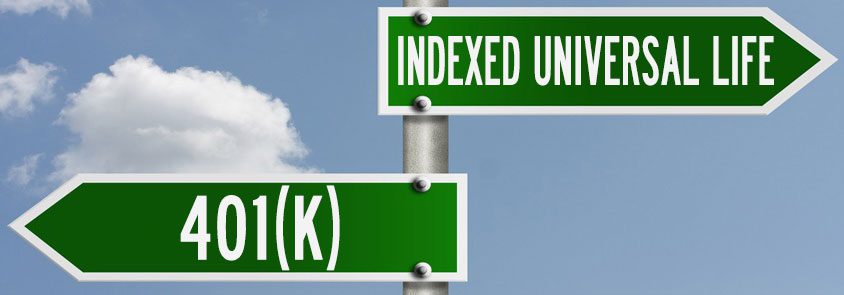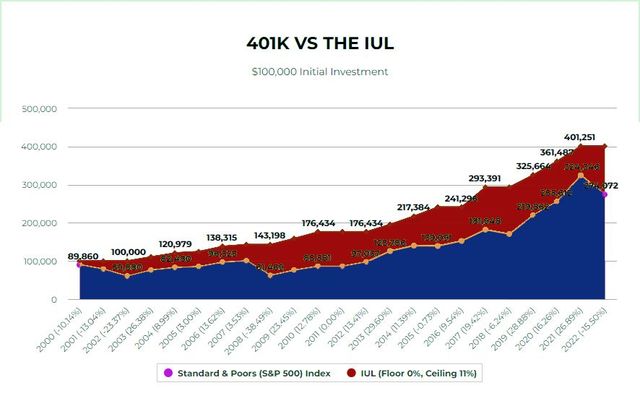All Categories
Featured
Table of Contents
Below is a theoretical contrast of historic efficiency of 401(K)/ S&P 500 and IUL. Let's presume Mr. SP and Mr. IUL both had $100,000 to saved at the end of 1997. Mr. SP spent his 401(K) money in S&P 500 index funds, while Mr. IUL's money was the cash worth in his IUL plan.
IUL's plan is 0 and the cap is 12%. Because his cash was saved in a life insurance plan, he does not need to pay tax!
Iul Vs 401(k): What's The Best Strategy For Your Retirement?

The numerous options can be mind boggling while investigating your retirement spending choices. There are certain choices that ought to not be either/or. Life insurance policy pays a death benefit to your recipients if you ought to pass away while the plan holds. If your family would face financial difficulty in the occasion of your fatality, life insurance policy uses peace of mind.
It's not one of the most successful life insurance policy financial investment plans, but it is just one of one of the most safe. A type of irreversible life insurance coverage, universal life insurance policy allows you to pick just how much of your costs goes towards your death benefit and how much goes into the policy to collect cash value.

Additionally, IULs permit insurance holders to get finances against their plan's cash money worth without being taxed as earnings, though unsettled balances may go through tax obligations and charges. The main advantage of an IUL policy is its possibility for tax-deferred growth. This implies that any revenues within the plan are not taxed until they are taken out.
Conversely, an IUL policy may not be one of the most ideal financial savings prepare for some individuals, and a traditional 401(k) might confirm to be a lot more useful. Indexed Universal Life Insurance Policy (IUL) plans use tax-deferred development capacity, defense from market recessions, and survivor benefit for recipients. They enable policyholders to earn rate of interest based upon the performance of a securities market index while protecting versus losses.
H Iule
A 401(k) plan is a popular retired life cost savings alternative that allows individuals to spend cash pre-tax into different investment tools such as mutual funds or ETFs. Companies may also offer matching payments, additionally enhancing your retired life cost savings capacity. There are 2 primary sorts of 401(k)s: traditional and Roth. With a typical 401(k), you can reduce your taxed earnings for the year by contributing pre-tax bucks from your income, while likewise benefiting from tax-deferred development and company matching contributions.
Lots of companies likewise offer matching payments, properly providing you cost-free money towards your retirement plan. Roth 401(k)s feature similarly to their traditional counterparts however with one secret difference: taxes on contributions are paid in advance as opposed to upon withdrawal throughout retirement years (Should You Consider an IUL Instead of a 401(k) Match?). This means that if you expect to be in a greater tax obligation bracket during retired life, adding to a Roth account could reduce tax obligations over time compared with spending only through standard accounts (resource)

With reduced monitoring charges usually contrasted to IULs, these sorts of accounts allow financiers to conserve cash over the long term while still benefiting from tax-deferred development capacity. In addition, several prominent inexpensive index funds are readily available within these account kinds. Taking circulations before reaching age 59 from either an IUL plan's cash money worth through financings or withdrawals from a standard 401(k) plan can lead to negative tax obligation effects otherwise dealt with carefully: While obtaining against your plan's money worth is generally considered tax-free approximately the amount paid in costs, any overdue loan equilibrium at the time of fatality or policy surrender might go through earnings taxes and charges.
Penn Mutual Iul
A 401(k) offers pre-tax investments, company matching contributions, and potentially more financial investment choices. The disadvantages of an IUL consist of greater administrative prices contrasted to typical retirement accounts, limitations in financial investment choices due to plan restrictions, and potential caps on returns throughout strong market efficiencies.

While IUL insurance policy may prove important to some, it is necessary to understand exactly how it functions prior to acquiring a policy. There are several benefits and drawbacks in comparison to other forms of life insurance policy. Indexed universal life (IUL) insurance plan provide higher upside potential, versatility, and tax-free gains. This sort of life insurance supplies permanent coverage as long as costs are paid.
As the index relocates up or down, so does the price of return on the cash money value component of your policy. The insurance business that provides the plan might supply a minimum surefire rate of return.

Economists often suggest living insurance protection that amounts 10 to 15 times your yearly earnings. There are several downsides related to IUL insurance coverage that critics fast to point out. Somebody who establishes the policy over a time when the market is executing poorly could finish up with high premium repayments that do not add at all to the cash value.
Other than that, remember the following various other factors to consider: Insurance provider can set participation rates for just how much of the index return you receive yearly. For example, let's state the plan has a 70% participation rate (iul calculator). If the index expands by 10%, your money worth return would certainly be only 7% (10% x 70%)
Additionally, returns on equity indexes are usually capped at an optimum amount. A plan may claim your optimum return is 10% per year, despite exactly how well the index performs. These limitations can limit the actual rate of return that's attributed towards your account every year, no matter of just how well the policy's hidden index carries out.
Iul Scam
IUL policies, on the other hand, offer returns based on an index and have variable premiums over time.
There are lots of various other kinds of life insurance policies, explained listed below. provides a set benefit if the insurance holder passes away within a collection amount of time, normally in between 10 and three decades. This is one of the most cost effective sorts of life insurance coverage, as well as the most basic, though there's no money worth build-up.
Life Insurance Vs. 401(k): A Guide For Retirement Savings
The policy gains value according to a repaired timetable, and there are less fees than an IUL policy. A variable plan's cash money value might depend on the efficiency of certain stocks or various other securities, and your premium can additionally change.
Latest Posts
Guaranteed Death Benefit Universal Life Insurance
Universal Life Policy Vs Term
Surrender Cost Index Life Insurance